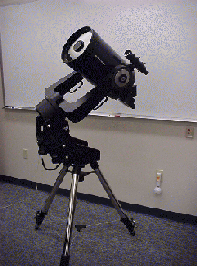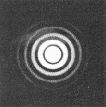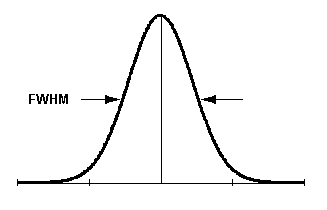The Telescope
|
This
introduction to the Meade 0.25 meter telescope explains some basics of astronomy and optics.
It also
discusses the limitations of a ground-based telescope and why
adaptive optics (AO) is necessary.
|
|
Basic Astronomy
 The stars in the sky are all pretty much like our Sun. Some are smaller, and some are bigger. Some are
cooler and more red in color, while others are hotter and more blue. Many
are actually two or more stars that orbit about each other. They all look like points of light because they
are so far away.
Because they are so distant, they also appear to be at fixed
locations on the sky.
The stars in the sky are all pretty much like our Sun. Some are smaller, and some are bigger. Some are
cooler and more red in color, while others are hotter and more blue. Many
are actually two or more stars that orbit about each other. They all look like points of light because they
are so far away.
Because they are so distant, they also appear to be at fixed
locations on the sky.
Astronomers gauge the apparent brightness of stars with a logarithmic magnitude scale. The stars
which appear brightest to the eye are said to have a visual magnitude of about 0. The next brightest have a visual
magnitude of 1, ones fainter than that have a value of 2, and so on. Each step up in magnitude is a decrease in brightness by a factor of about 2.5.
A telescope gathers a lot more light than your eye, so you can see much fainter stars. With our
0.25 meter telescope, we can easily see 8th magnitude stars, which are about 1000 times fainter than the
brightest stars in the sky.
Stars
are mapped on the sky using the equatorial coordinate system.
Declination
is equivalent to a latitude measured from the
Earth's equator. Right ascension is
like the Earth's longitude, measured on a circle starting
from a fixed point on the sky. Declination is measured in degrees, arcminutes, and
arcseconds. One arcminute is 1/60th of a degree. One arcsecond is 1/60th of an arcminute.
Right ascension is measured in hours,
minutes, and seconds.
Earth is spinning at a constant rate, making the stars appear to go in the opposite
direction. To counteract this, our telescope has an equatorial type mount. We align
the telescope mount with the north pole, and a motor
rotates it to counteract the motion of the Earth. This keeps the telescope pointed at the
same star in the sky.
Light produced from a point source, like a distant star, reaches Earth
essentially as flat wavefronts. A telescope focuses these waves to
form an image.
The aperture is the opening of the telescope which
allows the light to enter. However, some of the light is obstructed by
the secondary mirror and bracings. As a result, the
pupil is the net area of
wavefront that is collected by the telescope. Our telescope has an aperture
of 0.25 meters. About 20 percent of its collecting area is blocked by the secondary mirror.
Diffraction Limit
 There is a limit to
the sharpness of images a telescope can provide. This is the
diffraction limit, and it is a fundamental property of finite telescope aperture. As
wavefronts from a point source pass through the telescope
they are bent by the edges of the pupil. This process is called diffraction. These
bent wavefronts interfere with each other and produce an image that consists of a
central bright source with light and dark circular fringes around it. The width of the central peak of the diffraction
pattern is the finest separation between two objects that the telescope can discriminate. This is about 0.5 arcseconds for a 0.25 meter telescope.
The diffraction pattern can be made smaller by increasing the diameter of the telescope.
The largest optical telescopes in the world are the twin Keck telescopes in Hawaii.
They each have an aperture of 10 meters, and a diffraction limit 40 times smaller than our 0.25 meter
telescope. There is a limit to
the sharpness of images a telescope can provide. This is the
diffraction limit, and it is a fundamental property of finite telescope aperture. As
wavefronts from a point source pass through the telescope
they are bent by the edges of the pupil. This process is called diffraction. These
bent wavefronts interfere with each other and produce an image that consists of a
central bright source with light and dark circular fringes around it. The width of the central peak of the diffraction
pattern is the finest separation between two objects that the telescope can discriminate. This is about 0.5 arcseconds for a 0.25 meter telescope.
The diffraction pattern can be made smaller by increasing the diameter of the telescope.
The largest optical telescopes in the world are the twin Keck telescopes in Hawaii.
They each have an aperture of 10 meters, and a diffraction limit 40 times smaller than our 0.25 meter
telescope.
Atmospheric Limitations
Did you ever
notice that when you look down a straight stretch of road on
a hot day that objects in the distance appear to shake and shimmer? As hot air rises off
the road, different parts of the air are at different temperatures and, therefore, different densities.
These variations in density
cause the light to bend
and distort. The
same process affects light coming down from the stars, just not as
dramatically. Turbulent, convective air currents cause variations in
density which in turn cause stars to appear to jiggle.
Cool, smooth flowing air will have fewer density variations and so
the star's image will jiggle less.
This is why the best observatories are on mountain tops.
If the density variations are over a big enough scale, say, much larger than the
telescope aperture, the light is hardly effected at all.
However, if the
variations are all on very small scales, much smaller
than that of the telescope pupil, each section of the light will
be bent and distorted in complex ways - one part will go one way, another
part will go another way -
creating a blurry image.
The size of the regions of air that have the same density are measured by
Fried's parameter
(generally given the symbol ro)
and are usually about 0.05 to 0.2 meters.
 If ro
is about the same as the telescope aperture, an image of star will look a lot like the
diffraction pattern. As ro gets smaller the
star will
look more blurry. Astronomers usually
refer to the full-width at half maximum (FWHM) of a
star when gauging its blurriness.
The FWHM is the width of the star image at half its peak brightness;
the smaller the FWHM, the better the image, which will make it easier to resolve two very close objects.
A poor observing site will have star images with FWHM of 4 arcseconds or so. If ro
is about the same as the telescope aperture, an image of star will look a lot like the
diffraction pattern. As ro gets smaller the
star will
look more blurry. Astronomers usually
refer to the full-width at half maximum (FWHM) of a
star when gauging its blurriness.
The FWHM is the width of the star image at half its peak brightness;
the smaller the FWHM, the better the image, which will make it easier to resolve two very close objects.
A poor observing site will have star images with FWHM of 4 arcseconds or so.
Adaptive optics provides astronomy with the possibility of building optical
systems that correct for image distortions caused by
the turbulence in the atmosphere. If the only effect of the
atmosphere was to jiggle the star around, one could build a device with
a steerable mirror to measure and correct for its motion. This
type of camera is called a tip-tilt wavefront corrector and it is the simplest kind
of AO system. As ro gets smaller relative to
the telescope aperture, more sophisticated adaptive optical components are needed to
flatten the wavefront.
Go to an introduction to the tip-tilt camera.
Home |
Tip-Tilt Camera |
Manual |
Experiments |
Glossary |
People |
Visits/Publications
|

